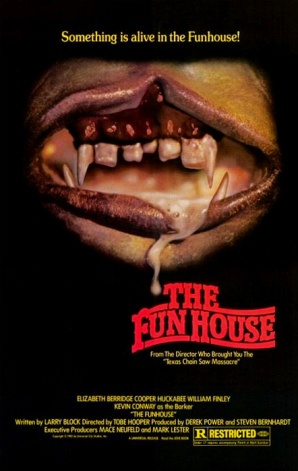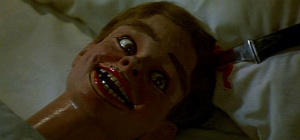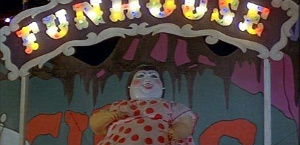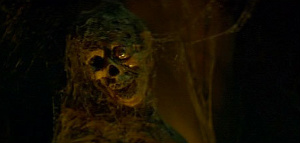
Despite winning major acclaim for The Texas Chainsaw Massacre, director Tobe Hooper had followed the success with a string of inferior and disappointing flops, most notably 1976’s Eaten Alive which starred future Freddy Krueger Robert Englund. His mini-series Salem’s Lot had given him some credibility back but he was desperate for another hit to revive his flagging career. 1981’s The Funhouse should have been the movie but it would take his next effort, Poltergeist, to launch him (temporarily) into the big time. Shame, as The Funhouse is an atmospheric and well made slasher which utilises its unique premise to the best of its ability. It would also be accompanied by a best selling novel by horror author Dean Koontz and would become a subject of debate in Britain during the mid-eighties when it was banned for a short time under the Video Recordings Act 1984 due to being labelled as a ‘video nasty.’
In an explicit homage to both Halloween and Psycho‘s infamous shower scene a figure enters a house and makes its way upstairs, finding a knife and mask along the way. Amy Harper (Elizabeth Berridge), an attractive teenager, disrobes and climbs into the shower. Soon afterwards the figure creeps into the room and suddenly pulls the shower curtain back, thrusting the blade down repeatedly into her chest. To her surprise, the knife is revealed to be a fake and the assailant is her young brother, Joey (Shawn Carson). She vows to one day take revenge and threatens to leave him at home when she visits the carnival at the weekend. When the evening in question comes around Amy is confronted by her parents who demand that she keeps away from the carnival but she has already arranged to meet up with her boyfriend, Buzz (Cooper Huckabee), and their two friends Liz (Largo Woodruff) and Ritchie (Miles Chapin), and so pretends to go to the movies instead.

Although left at home, Joey sets out to spy on his older sibling and so heads towards the fairground. Meanwhile, Buzz has brought some pot and the four of them have a smoke before heading into the carnival. In between the various rides and attractions, Amy comes across the token prophet of doom, an old lady (Sonia Zomina) who warns her that God is watching. They soon come across an intriguing tent in which the creep outside (Kevin Conway) attempts to coerce them into entering. Instead they decide to view a magic show hosted by Marco the Magnificent (William Finley) in which he seems to stab her in front of a disillusioned audience. Another staple of carnivals is the fortune teller, and so the friends visit the alcoholic Madame Zena (Sylvia Miles), who soon tires of their tomfoolery and demands that they leave.
After viewing other bizarre sights including a creepy figure in a Frankenstein mask (Wayne Doba), Buzz suggests that they hide out until the rides close down and spend the night. They make their way into the funhouse and, unknown to them, Joey waits outside for their return. Whilst exploring, they witness the Frankenstein man pay Madame Zena for sex, only for him to prematurely ejaculate and demand his money back. When she refuses he strangles her and then panics. After it leaves, the friends head down to see if she is still alive, but Ritchie steals the money without telling his friends and they attempt to find an escape. The figure’s father appears and he shows him what he had done, but the father grows more concerned when he discovers that the money has been stolen. Soon they realise that they are not alone and proceed to hunt down the intruders, silence the witnesses and claim back their money.

Perhaps The Funhouse‘s most impressive aspect is the production design by Mort Rabinowitz (whom the director had previously collaborated with on Salem’s Lot), which makes full use of the bizarre and macabre setting of a carnival freakshow. The cinematography, by Andrew Laszlo (who would later work on First Blood, Innerspace and Star Trek V: The Final Frontier), is equally stunning, with deep colours adding a psychedelic and Tim Burton-esque feel to the movie. Hooper’s direction has never been so assured, proving that The Texas Chainsaw Massacre was not a one hit wonder and that with a substantial budget and a decent script he was capable of delivering effective and atmospheric horror films. The main flaw is with its antagonist, who is extremely creepy whilst wearing the Frankenstein mask but loses all sense of dread and terror when his face (a grotesque monster) is finally revealed.
Unlike many slashers of the era, The Funhouse boasts a talented cast of relative unknowns. Despite many of the principals being far older than their teenage roles, Berridge makes for an impressive final girl and Carson proves to be one of the few child actors to not be constantly irritating. By far the best performance came from Doba, a mime artist who was making his acting debut, displaying all manner of body language due to his lack of dialogue. Thankfully, Lawrence Block’s screenplay (his first produced effort) avoids many of the slasher pitfalls (such as clichéd dialogue) and Hooper makes the most out of the interesting location. By far one of the more intriguing of the early eighties slashers and certainly more impressive than many of the films that score big at the box office (most notably Prom Night), The Funhouse is a must for slasher fans.


10 Responses to The Funhouse (1981)